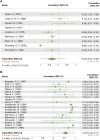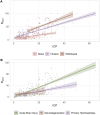CSF production rate, resistance to reabsorption, and intracranial pressure: a systematic review and meta-analysis
- PMID: 39949404
- PMCID: PMC11822472
- DOI: 10.1093/braincomms/fcaf044
CSF production rate, resistance to reabsorption, and intracranial pressure: a systematic review and meta-analysis
Abstract
Davson's equation relates the state of stable intracranial pressure (ICP) to the production rate of CSF (IF) and resistance to CSF outflow (ROUT). Both parameters are assumed to be independent of ICP, but results are conflicting. The objective is to define the relationship between ICP, IF and ROUT using a systematic literature review. Medline and Embase were searched from inception up to 12 February 2024. Experimental studies exploring the association between ICP, IF, and ROUT were included. Individual measurements of ICP, IF and/or ROUT were extracted from tables or graphs, alongside descriptive parameters (population, ICP measurement site, disease, and computational method). Linear regression and mixed effects models were applied. From 1304 references, 25 articles were included in our meta-analysis. IF is approximately constant across all pathologies independent of the ICP level, population, disease, ICP measurement site and the measurement/estimation method. Conversely, ICP was positively correlated with ROUT. The intercorrelation, however, differed by population, disease, ICP measurement site and estimation method. Additionally, IF derived from Davson's Equation compared with the measured IF were similar for patients with hydrocephalus but differed for patients with acute brain injury. Davson's Equation describes the various components of cerebrospinal fluid dynamics. The results underline important caveats for its use in patients with acute brain injury wherein the estimated values differ from the measured ones. Overall, additional metrics describing the cerebrovascular system or the underlying disease have to be taken into account for more accurate estimations.
Keywords: cerebrospinal fluid; intracranial hypertension; intracranial pressure; meta-analysis; systematic review.
© The Author(s) 2025. Published by Oxford University Press on behalf of the Guarantors of Brain.
Conflict of interest statement
Nothing to report.
Figures






References
-
- Matsumae M, Sato O, Hirayama A, et al. . Research into the physiology of cerebrospinal fluid reaches a new horizon: Intimate exchange between cerebrospinal fluid and interstitial fluid may contribute to maintenance of homeostasis in the central nervous system. Neurol Med Chir (Tokyo). 2016;56(7):416–441. - PMC - PubMed
-
- Eklund A, Smielewski P, Chambers I, et al. . Assessment of cerebrospinal fluid outflow resistance. Med Biol Eng Comput. 2007;45(8):719–735. - PubMed
Publication types
LinkOut - more resources
Full Text Sources
